The golden city of Prague is many things to me: my birthplace, my heritage, my home briefly after the “Velvet Revolution”…and an old friend that I go back to visit once in a while, just to keep in touch. It’s the perfect European city to visit even if just for one day, as it’s safe, affordable, walkable…and beautiful!

Following is a packed one day itinerary for anyone eager to explore this majestic city. It includes some of the major sites with some tips for where to eat. There are numerous hotels, many of them quite reasonably priced, near any of the sites below. The underground metro consists of only three lines and is very simple to navigate.

You can purchase a one day pass for unlimited use of the metro and tram lines, however I find it just as manageable to spend the day walking to each of the below sites, as you will see more of Prague that way!
Václavské Náměstí (Wenceslas Square)
You might consider this the main square of Prague. It’s the location of the Národní Muzeum (National Museum). The National Museum is worth a visit if you’re a history buff, as it contains over 14 million items of Czech history.

There’s also the Statue of Saint Wenceslas (Svatého Vácalva) atop a horse at the head of the square. Saint Wenceslas was a Duke of Bohemia in the 1st century AD and was known for his piety and kindness. This square has been the site of some of the most important events in Czech history, including the rally at the time of Czech independence in 1918 and the regaining of independence in 1989.
The square is surrounded by hotels, restaurants, shopping and administrative buildings. I like to stop at the Luxor bookstore which has a small selection of English language books, guidebooks and maps.
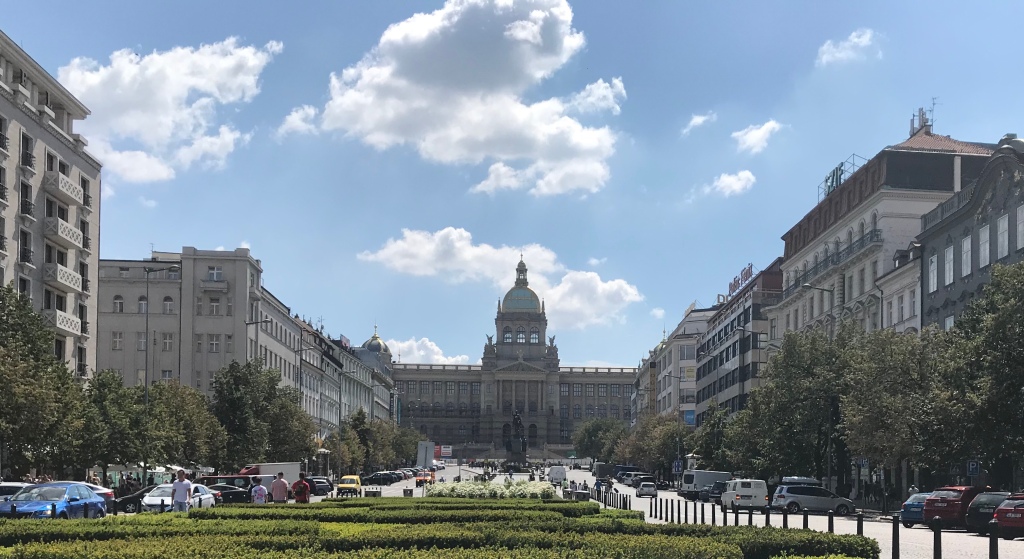
A number of fast food chains have cropped up in recent years in the area so you can always get a cheap burger and of course there’s a Starbucks. It would be better to walk down the cobble stoned streets that line both sides of the square and perhaps stop at a more typical Czech restaurant, like Café Svatého Vácalva, though expect to pay tourist prices.
If it’s the morning you may as well just get a coffee and pastry before moving on to the Republic Square. A pleasant way to do this is to take a left turn down Vodičkova Street and find the Františkánská Zahrada (Franciscan Gardens) for a peaceful respite from the crowds. It’s a quiet little park and garden with benches where you can sit outside and rest for a bit. Get a coffee to go from the nearby Head Shot Coffee and take it with you to enjoy in the gardens.
Once back on Wenceslas Square, take a right at the Můstek metro stop and walk down Na Přikopě toward the Republic Square. You will also find many shops and cafes along this street.
Náměstí Republiky (Republic Square)
This is a square that was built at the site of the former moat between the Old and New Towns. Two of the most significant buildings to see here is the Obecní dům (Municipal House) and the Prašná brána (Powder Tower).

The Municipal House has a stunning mosaic by the artist Mucha above its entry.
Daily you can purchase tickets to see a variety of classical concerts that play each evening in the building, something that I highly recommend doing. I saw a concert at 7pm during the week in a small room where you were up close to the musicians and the sound was wonderful. For more information see their website here.
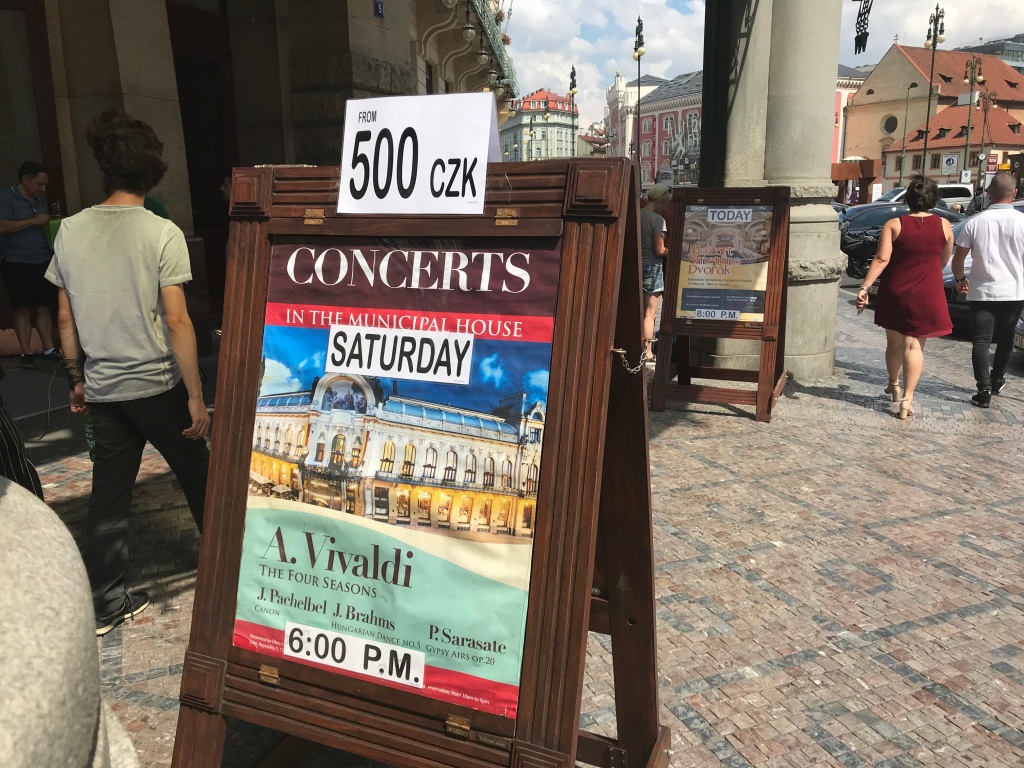
If you are more in the mood for a coffee or tea and dessert, perhaps before or after a concert, try Cacao on V Celnici street for a big selection and free WiFi.

You can find reasonable places to grab lunch or a snack at Republic Square. Most of the square is a pedestrian area that stretches between two large shopping centers, Palladium and Kotva. The Palladium has a large food court where you can get Czech food as well as several other cuisines. Be on the lookout on the main floor for displays of “Chlebičky” which are open-faced Czech sandwiches and typical for a quick bite. You must try one!
Many Czech restaurants offer pizza and pasta on their menu in addition or instead of the typical Czech items in an effort to cater to tourists. If that is what you are in the mood for, I can recommend the brick-oven pizza at Pizza Nuova on Revoluční street. The two-story restaurant has plenty of seating, and I enjoyed the individual ham and artichoke pizza which rivaled anything I’ve had in New York.

The Powder Tower, completed in 1475, was the original gateway to the Old Town. It was the beginning of the royal coronation procession of Czech Kings on the way to the Prague Castle. It used to store gunpowder, hence why it is called the Powder Tower.
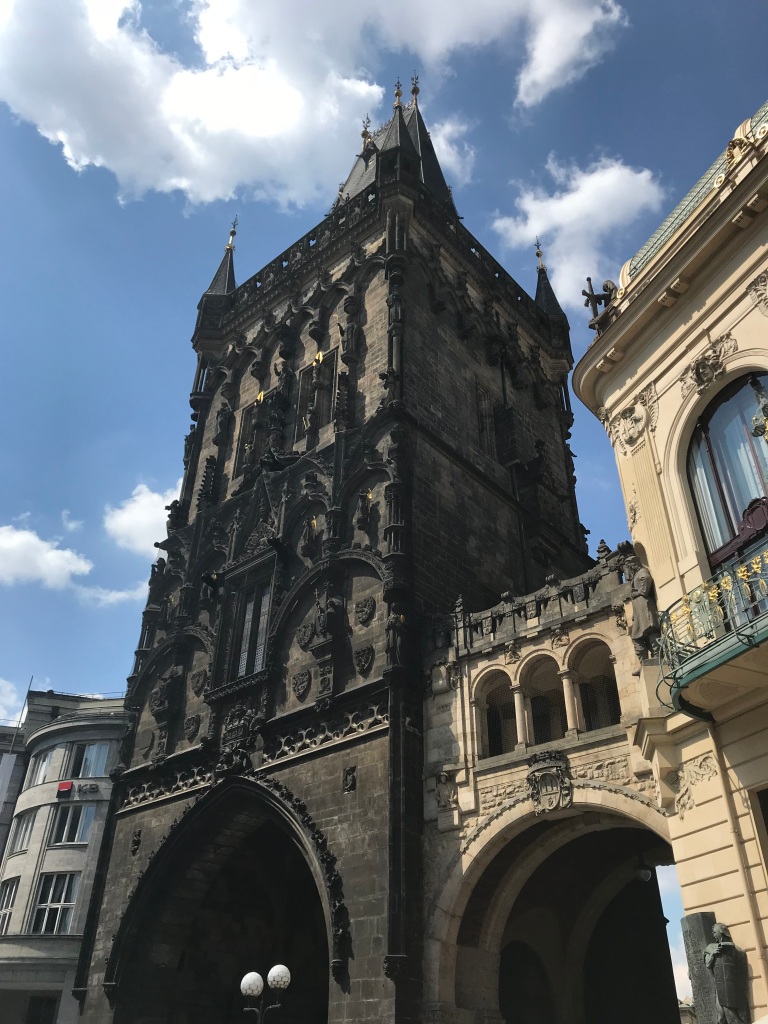
You can purchase tickets to go up the tower for a nice view of the surrounding area.
Staré Město (Old Town)
It can be a little tricky to wind your way through the maze of cobblestoned streets towards the Charles Bridge, but you can generally follow the crowds from Celetná street and will be rewarded by a visit through the Old Town on the way.
The large square of The Old Town is centered around the statue of Jan Hus and has several notable sites.

Jan Hus was the revolutionary leader of the Hussites, a theologian and church reformer in the early 15th century, influenced by John Wycliff. Eventually Jan Hus was charged as a heretic and was burned at the stake.
On the right of the square is Chrám Matky Boží před Týnem (The Church of our Lady before Tyn), or simply called the Tyn church, and was once the central Hussite church.

It is still a functioning church, and its towering spires can be seen from most of Prague. Inside is golden and glorious, and includes 19 decorated alters, a statue of the Madonna and child, and works of Gothic art. Tickets to tour the church can be purchased at the door.
Back outside on the square, notice the 27 Crosses in the cobblestoned pavement of the square close to the Astronomical Clock. It is in memory of 27 war prisoners from the 1620 Battle of White Mountain, who were sentenced to death and executed at this site.

You can read more about the Battle of White Mountain here.
The Astronomical Clock at the foot of the square is the world’s oldest working clock, dating from the 14th century.

It is a marvel of medieval times and provides not just the time but gives viewers astronomical and zodiac information as well. When the clock strikes on the hour, you will notice 12 apostles that move in a circular motion through two windows above the clock.

This is a very popular thing for tourists to see, and it’s worth timing your visit so that you get a good viewing spot before the hour strikes.
Karlův Most (Charles Bridge)
You can roughly follow Staromětské street onto to Karlova street which will lead you to the Charles Bridge.

The Charles Bridge was commissioned by King Charles IV and built in the late 14th century to connect the Old Town across the Vltava river to the Prague Castle. With its 16 arches and 30 stone statues commemorating various saints, it is one of the most visited sites in Prague. One of the most famous statues is the one of Saint Nepomuk near the center of the bridge.
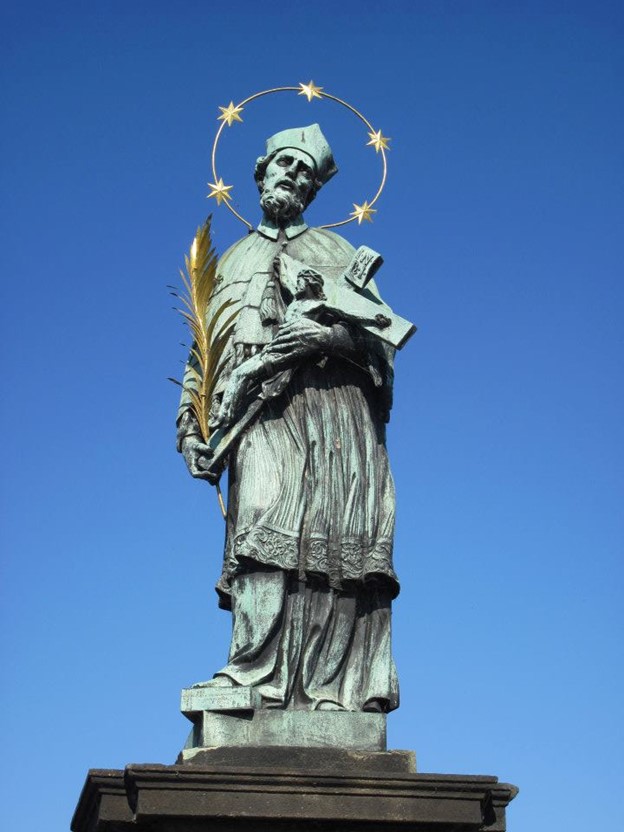
Rubbing it is said to bring good luck and a return to Prague.
The view of the castle from the bridge is fantastic and iconic.

Pražký Hrad (Prague Castle)
The Prague castle is a medieval castle which was rebuilt in the Gothic style under the rule of Charles IV in the 14th century. In later years Renaissance buildings were added to it, and a tour of the castle is a great way to see examples of both styles. The castle grounds include cathedrals, museums and gardens, and is currently the seat of the President of the Czech Republic.

Tickets to tour the inside of the St. Vitus Cathedral can be purchased onsite, but lines can be long so buy in advance if possible. Tickets include access to the Zlatá ulička (Golden Lane), a small street adjacent to the castle with tiny, colorful houses. This historical street from the 16th century is where alchemists lived at the time working on unraveling the mystery of the artificial production of gold. Going inside the houses gives you a peek into what life was like in those times.

One of the most famous houses in Golden Lane is No. 22, where the writer Franz Kafka later lived and worked from 1916-1917.
From the Golden Lane you can walk down the famous Old Castle steps through Malostranská (Lesser Town) and back towards the Charles Bridge and Old Town.
There are numerous restaurants along the riverbanks, and you may even want to consider an evening river cruise.

I recommend heading back to the Old Town square and getting dinner sitting outdoors at one of the restaurants that line the square and having a typical Czech meal and beer to end the day. These restaurants might be a little on the pricey side, but you will get an excellent quality meal and the people-watching is worth it. Might I recommend a Czech Goulash with Knedliky, washed down with a large Staropramen beer?
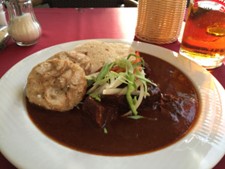
However you end your stay in Prague, this one day tour of some of the major sites in Prague will certainly whet your appetite for more history, art and architecture, good food and beer, and the many other attractions in and around the majestic city of golden Prague.

Thank you for a very complete tour of Prague. We went there years ago, before the massive crowds and enjoyed every minute of it.
🙏🏻
LikeLike
Thank you! So glad you enjoyed your trip there!
LikeLiked by 1 person
Thanks to you for the memories. 🙏🏻
LikeLike